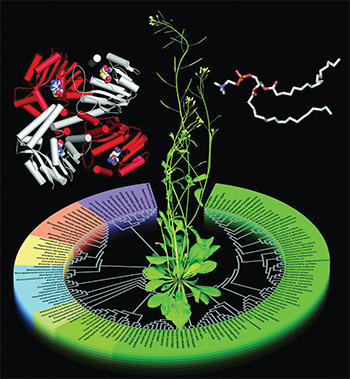JBC: A phospholipid pathway from plants to parasites
Findings by researchers at may aid in the development of therapies to treat parasitic infections, including malaria, and may help plant scientists one day produce hardier crops. The research team’s in the Journal of Biological Chemistry.
 A study explains how structures of Arabidopsis phosphoethanolamine methyltransferase, or PMT, (left) are evolutionarily related to PMT sequences from different organisms. Phosphatidylcholine (right) is PMT's product. Courtesy of Soon Goo Lee and Joseph JezCholine is an essential nutrient that we get from certain foods, including eggs, meat, leafy greens and nuts. The human body converts choline into phosphocholine, or pCho, which it in turn converts into (among other essential building blocks) phosphatidylcholine, or PtdCho, a component of cell membranes. Plants can’t acquire the nutrient from the environment and so must synthesize pCho from scratch. The biochemical pathway plants use to synthesize pCho also is found in nematodes and the malaria parasite Plasmodium.
A study explains how structures of Arabidopsis phosphoethanolamine methyltransferase, or PMT, (left) are evolutionarily related to PMT sequences from different organisms. Phosphatidylcholine (right) is PMT's product. Courtesy of Soon Goo Lee and Joseph JezCholine is an essential nutrient that we get from certain foods, including eggs, meat, leafy greens and nuts. The human body converts choline into phosphocholine, or pCho, which it in turn converts into (among other essential building blocks) phosphatidylcholine, or PtdCho, a component of cell membranes. Plants can’t acquire the nutrient from the environment and so must synthesize pCho from scratch. The biochemical pathway plants use to synthesize pCho also is found in nematodes and the malaria parasite Plasmodium.
In plants, the enzymatic reaction that produces pCho is essential for normal function and for responding to stresses. Plant pCho is converted into PtdCho, which builds membranes that can adjust their rigidity in response to temperature changes. pCho also gets converted into molecules that help plants survive high salt. The enzymes that produce plant pCho are called phosphoethanolamine methyltransferases, or PMTs.
, a postdoctoral research fellow at Washington University in the lab of (a JBC associate editor), has been fascinated by PMTs in both plants and parasites for many years.
“Understanding the PMT enzyme is key to engineer plants with improved stress tolerance and enhanced nutrients,” Lee said.
Since the PMT-catalyzed pathway is found in parasites but not humans, Lee and Jez’s team is looking for inhibitors of this enzyme to treat diseases caused by these parasites.
The new study explains that PMTs of the model plant Arabidopsis thaliana share core features of PMTs from parasites, with almost identical structure at the active site. But the plant PMTs are roughly twice as large as the parasite ones, with large sections that can rearrange themselves to carry out multiple chemical reactions.
The three PMT types in the plant — which were thought to carry out the same function — actually appear to play different roles depending on where they are found in the plant. Plant growth experiments showed that one type of PMT was essential for root development and salt tolerance, whereas the other two had no effect on roots and instead seemed to be found primarily in leaves.
In the long run, this big-picture view of PMTs in different organisms offers routes to engineer enzymes with different functions. “I love these kinds of stories,” Lee said, “where I can look from the atomic (structure) to the physiological level to explain why these enzymes have different forms and how they work.”
Enjoy reading 91—«…´¥´√Ω Today?
Become a member to receive the print edition four times a year and the digital edition monthly.
Learn moreGet the latest from 91—«…´¥´√Ω Today
Enter your email address, and we’ll send you a weekly email with recent articles, interviews and more.
Latest in Science
Science highlights or most popular articles

Bacterial enzyme catalyzes body odor compound formation
Researchers identify a skin-resident Staphylococcus hominis dipeptidase involved in creating sulfur-containing secretions. Read more about this recent Journal of Biological Chemistry paper.

Neurobiology of stress and substance use
MOSAIC scholar and proud Latino, Bryan Cruz of Scripps Research Institute studies the neurochemical origins of PTSD-related alcohol use using a multidisciplinary approach.

Pesticide disrupts neuronal potentiation
New research reveals how deltamethrin may disrupt brain development by altering the protein cargo of brain-derived extracellular vesicles. Read more about this recent Molecular & Cellular Proteomics article.

A look into the rice glycoproteome
Researchers mapped posttranslational modifications in Oryza sativa, revealing hundreds of alterations tied to key plant processes. Read more about this recent Molecular & Cellular Proteomics paper.

Proteomic variation in heart tissues
By tracking protein changes in stem cell–derived heart cells, researchers from Cedars-Sinai uncovered surprising diversity — including a potential new cell type — that could reshape how we study and treat heart disease.

Parsing plant pigment pathways
Erich Grotewold of Michigan State University, an 91—«…´¥´√Ω Breakthroughs speaker, discusses his work on the genetic regulation of flavonoid biosynthesis.

.jpg?lang=en-US&width=300&height=300&ext=.jpg)